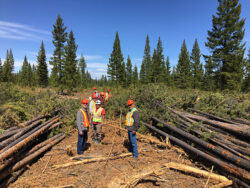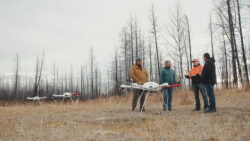
Features
Indigenous partnerships: The FESBC experience
June 26, 2023 By Steven F. Kozuki
 DroneSeed staging three heavy-lift drones in preparation to disperse seed vessels over the Chilcotin plateau. Photos courtesy of FESBC.
DroneSeed staging three heavy-lift drones in preparation to disperse seed vessels over the Chilcotin plateau. Photos courtesy of FESBC. For a very long time, the forests of British Columbia have been a source of life, providing resources for communities and habitats for wildlife. However, in recent years, the impacts of pine beetles and other destructive events have threatened these forests and the ecosystems they support. That’s where the Forest Enhancement Society of BC (FESBC) comes in.
Since 2016, FESBC has worked toward fulfilling a number of significant purposes: to help utilize low-quality forest fibre, accelerate ecological recovery in the aftermath of pine beetle and other damaging events, while at the same time improving wildlife habitat, reducing greenhouse gases, reducing wildfire risk to communities, and achieving other objectives. FESBC has been undertaking a lot of these projects in partnership with First Nations communities, who have long been stewards of the land and have a deep connection to the forests they call home.
It’s heartening to see that about 30 per cent of the funding approved by FESBC has gone toward projects led by or involving First Nations. At first, FESBC was taken by surprise by the overwhelming interest shown by Nations, but in hindsight, it’s clear that it was a natural fit. The First Nations’ connection to the land and deep-rooted sense of responsibility has made them the perfect partners for these initiatives. The strong caretaker mindset of First Nations communities, combined with their intimate knowledge of the forests, continues to prove to be a real asset in these efforts to restore and protect the land for generations to come.

Tour of the Central Chilcotin Rehabilitation wildfire risk reduction and forest rehabilitation project.
Jeff Mosher, RPF, planning manager, Taan Forest said, “Funding from FESBC allowed us to move forward with treatments to the land, which incorporated Haida culture and will benefit many species like the black bear. The project will also restore forests within the river valley with benefits to salmon and other fish, and many spin-off benefits to goshawk, eagles, saw-whet owls, bats and many other resident and migratory birds.”
The partnerships between the FESBC and First Nations has exceeded all expectations and is transforming the forestry landscape in British Columbia. While the initial basis for the partnership was contractual, FESBC’s approach and business model have allowed for a deeper and potentially transformative relationship to emerge:
- FESBC employs a proponent-driven application model where local people decide what projects they wish to undertake. The Nations themselves propose the projects, so there is never any sense that something is being imposed on them.
- FESBC projects don’t have other baggage to hinder the relationship. FESBC never leverages project funding to extract any form of quid pro quo from the Nations (concessions or consent related to rights, title, accommodation, etc). Without baggage, the relationship can become deeper than just contractual and transactional.
- FESBC funds 100 per cent of project costs that are fair and reasonable on a case-specific basis, including administration. It would be prejudicial to require a financial contribution to the project from a First Nation that doesn’t have a tax base.
- FESBC is willing to take calculated risks outside of the box. For example, FESBC supported a Nation who wanted to use cutting edge, unproven technology to plant tree seeds using GPS-guided drones.
- FESBC is willing to use Indigenous knowledge and let traditional fire-keepers provide leadership on re-establishing ecological balance in fire-prone areas to protect communities from catastrophic wildfires.
- FESBC allows Nations to lead the projects, which means they plan when, where, and how the projects are carried out. This kind of empowerment can be transformational.
One of the most innovative and exciting partnerships with First Nations that FESBC has formed is the DroneSeed project with Central Chilcotin Rehabilitation Ltd. (CCR) in the aftermath of a very large complex of wildfires in 2017. In the operational reforestation trial conducted in 2022, drones and hand deployment were used to direct seed an area equivalent to 128 football fields (52 hectares) with thousands of Lodgepole pine and Douglas fir. The seeds were carefully placed in vessels or pods containing a mixture of materials and nutrients to maximize their chances of germination and survival. The success of this project could mean that large areas impacted by fires can be restored much faster than traditional methods, which rely solely on manual planting. This project involved the use of cutting-edge drone technology to replant areas affected by wildfires and other disturbances.

(L-R): Paul Grinder (councillor, Tl’etinqox Government), Dave Conly (former operations manager, FESBC), Grant Canary (CEO, DroneSeed), Percy Guichon (director, CCR) on site for the DroneSeed planting.
This innovative project was bound to invite skeptics, but FESBC was willing to take a calculated risk and support the project, recognizing the potential benefits of using this innovative technology. The partnership with CCR allowed for Tsideldel First Nation and the Tl’etinqox Government, who are joint owners of CCR, to become leaders in forest management in their traditional territories.
Danny Strobbe, former forestry superintendent, Tsi Del Del Enterprises said, “FESBC funding was an efficient way to not only deploy funds in rural communities where the impacts of the mountain pine beetle and wildfires are felt the most, but also created opportunities to leverage private money to do more and build new relationships with other companies and communities.”
Today, FESBC has gained much from such relationships with First Nations, including a greater appreciation for the inter-connectedness of all things in our natural world and in communities. Forestry is not only an engine for local economies and a significant mechanism to achieve environmental goals. It can also be a means to create profound social good. The jobs created in remote and rural areas sometimes do more than just provide a paycheck. Increased self-esteem can result in numerous social benefits from healthier families and healthier communities.
Steve F. Kozuki is the executive director of the Forest Enhancement Society of BC.
Print this page